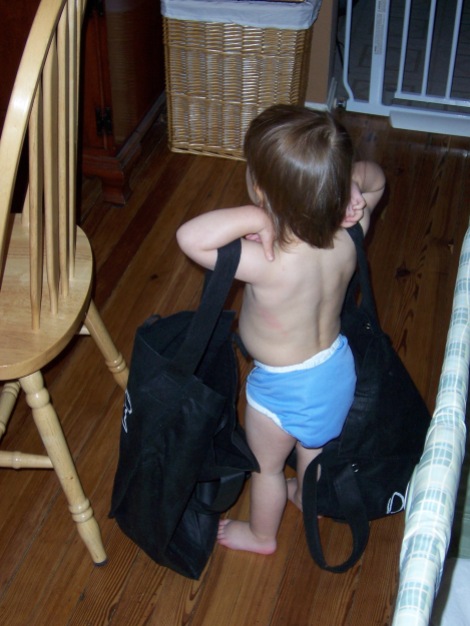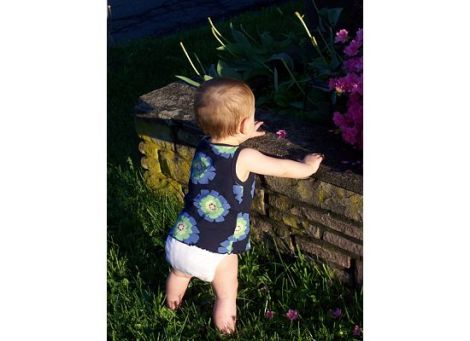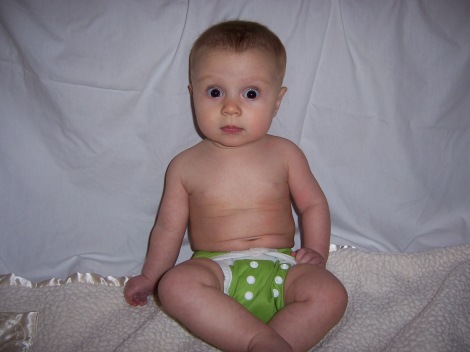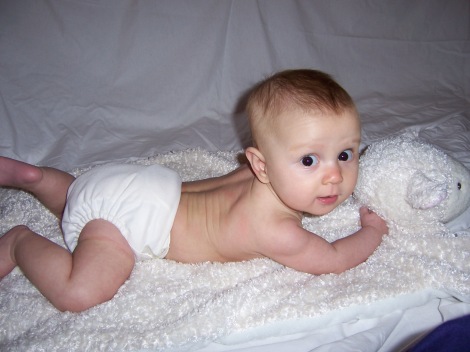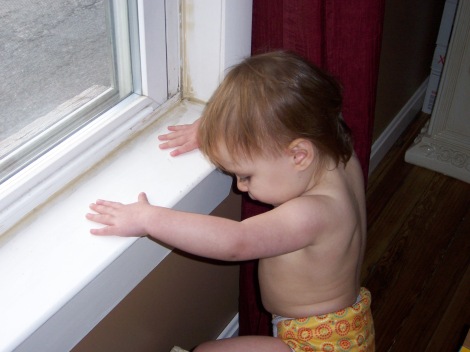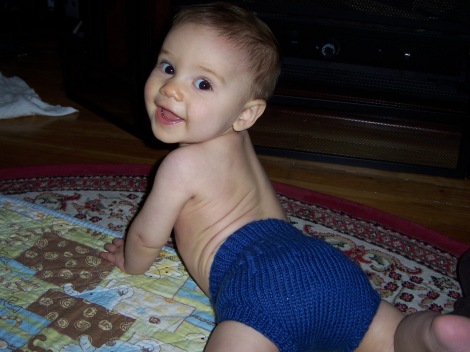I totally understand that cloth diapers are not for everyone. I am not even a cloth diaper purist. I’ve been known to use disposables when we travel or when my children will be under the care of others for an extended period of time. (Such as our five day trip to Colonial Williamsburg). Fortunately my family is very cloth diaper friendly and I even converted my sister to using them as well.
But I really can’t stand the misinformation that is peddled by many disposable diaper companies and distributors. So I feel the need to provide a little balance to their propaganda. These are some reasons this particular company claims disposable diapers are better.
Convenience.
Yes, disposable diapers are convenient. You can throw them out anywhere and they can be purchased relatively easily. But on the flip side, cloth diapers can be nearly as convenient. When I’m out with my kids, and I need to change a diaper I pull out a clean diaper and a wipe. Change the diaper and then instead of throwing away the diaper, I just put it in the wet bag and throw it in the diaper pail when I get home. Depending on where you are, you may need to do this with a disposable anyway. Regarding the dumping of feces of diapers, this should be done with ALL diapers, not just cloth. Disposable diapers should not be thrown away with the poo still in them. Yes, I know we all have done that at one time or another. But the long term environmental impact of tons (and I mean actual metric tons) of feces wrapped in non-biodegradable plastic in a landfill is disgusting if not terrifying.
Expense.
It has also been argued that disposables are less expensive because they can be purchased in bulk. In fairness, cloth diapers cost more up front for sure. But they get used many, many times as opposed to the one use disposable diaper. (There are cases of those who reuse disposable diapers, but this is very dangerous and unhygienic, causing infection and sometimes death in babies.) There are so many varieties of both reusable and disposable diapers that it’s hard to show definite numbers. There are ways to make either option fit your budget, but generally, cloth will be less expensive in the long run. Especially if you are able to reuse your cloth diapers for future children.
Efficacy (i.e. comfort) and Absorbency.
I’m a little tired of the argument that disposable diapered babies always have less diaper rash. Several studies have shown that prior to the invention of disposable diapers rashes were a normal part of babies’ lives, but not common by any means. Since disposable diapers have been almost exclusively embraced by so much of the western world, incidents of diaper rash are up significantly. Yes, I realize that some children need the “super dry” feeling provided by disposables. But products like fleece liners or fabric like suede cloth can help provide the same function for a cloth diaper, at least until fully saturated. I also feel the need to point out that regardless of how much a disposable diaper “can” absorb, most pediatricians recommend that no baby be left in any diaper (cloth or disposable) longer than four hours (less for newborns). Ideally your baby should be changed immediately when his or her diaper is wet or soiled. Obviously this isn’t always possible. Just because the diaper may or may not leak doesn’t mean your kid should sit in it for 6 or 8 hours at a time. Let me tell you, a fully saturated disposable feels wet too. My son has had a few nights in disposables for various reasons and most times when he woke up, he was soaked from crotch to chin and the extra urine was actually rolling around inside of the soaked disposable diaper. Plus, the little fluid absorbing pellets were all over him. I’m not crazy about my child’s genitals being exposed to those toxic chemicals. (Though it concerned me more with my daughter since these are the same super absorbent chemicals that were banned in tampons).
As far as absorbency goes, that also varies widely. It is “generally” regarded, that disposables are more absorbent than cloth, but that really depends on the product. Not all disposable diapers are equally absorbent and many of the more “eco-friendly” options are less so because they use less of the super absorbent chemicals that many parents are concerned about. Cloth has so many absorbency options from micro-fiber and cotton to hemp and wool. Some parents actually switch to cloth diapers to get better overnight absorbency then disposables.
Environmental Impact.
If I have to hear this argument one more time I may personally mail a poopy cloth diaper to that offending PR rep. Saying that washing cloth diapers is as bad for the environment as disposable diapers sitting in a landfill is like saying that using disposable plates or throwing away all your children’s clothes has an equal environmental impact to doing dishes and laundry. If you are overly concerned about the environmental impact of the resources used in the manufacturing and care of cloth diapers there are many ways around that. There are organic products available. Many diaper companies recommend line drying your diapers to reduce wear and tear, which has additional environmental benefits. But let’s keep in mind that in the average child’s life, he or she will produce nearly 1 ton of garbage in disposable diapers alone. (In most cases, those calculations don’t even include disposable training pants like pull-ups which can continue another few years after your child is officially “out of diapers”.) I really don’t think that doing an extra three or four loads of laundry a week can be fairly compared to 1 ton of waste in a landfill.
Most studies quoted by disposable diaper companies claiming equal environmental impact are older studies that use comparisons of diaper services to the use of disposable diapers. In the past, diaper services used super hot water and high levels of toxic chemicals to clean diapers. Not only is this no longer the case of modern diaper services, most cloth diaper users today wash their diapers at home. The “special” detergent I use is actually less expensive and more eco-friendly then most main stream diaper detergents. But many families do fine washing their diapers in standard detergent, albeit much less than the recommended amount. Most cloth diaper users rarely use bleach, and in fact doing so voids the warranty on most diapers. (The exception being that I occasionally bleach my micro-fiber inserts, as recommended by bumGenius). As opposed to the large quantities of bleach used to make disposable diapers white. (Disposable diapers are actually clear but that would look disturbing to most parents so the plastic is dyed and bleached white. Even eco-friendly brands like 7th generation dye their diapers for effect.)
Fit and Comfort
I find this argument perhaps the most mystifying of all. Cloth diapers are available in many different sizes as well as one-size varieties; the advantage of one-size being that you buy fewer diapers and spend less money. Of course disposable diapers are available in so many sizes. They want you to size up as often as possible (many times before the previous package is finished) so that you have to buy more diapers. I think what I hate most about this argument is that it seems to imply that there are so few options when it comes to cloth diapers. When in fact there are more options available than disposables. With the exception of a few companies who use alternate absorbent materials (like corn, or unbleached wood pulp), all disposable diapers are about the same. They have different pictures printed on them, but really they are all the same basic design and ingredients. Where as with cloth diapers, there are so many different styles, sizes, colors and fabrics. You are almost guaranteed to find something that will work for your baby and your budget. In some cases you can even resell your diapers when you are done to recoup some of the cost.
I’d like to add one more of my own.
Attractiveness.
Yes, sometimes cloth diapers can be bulkier, though I mostly find this to be the case at night when aesthetics matter less to me. But during the day I don’t find the extra bulk unattractive, if anything it’s cute and provides extra support for my son’s bottom as he learns to walk. In the cuteness department, you can’t beat cloth diapers. I don’t care what kind of kid’s cartoons you plaster on them, disposable diapers are just plain ugly. No wonder they put bloomers under little girls dresses. (Ugly diaper butt anyone?) When my daughter was little, I would pick out a bumGenius that most closely matched her dress and she was good to go.
As I said earlier, I recognize that cloth diapers are not for everyone. I admire companies like g-diapers that have pursued hybrid options for areas where water use is an issue. But for the majority of us, water is more readily available than landfill space. I don’t object to families using disposable diapers when it is the right decision of them. But it really irks me when biased and often inaccurate information about cloth diapers is dissembled as fact, to discourage and perhaps even scare families away from cloth diapers. Cloth diapers are a legitimate and potentially healthier and less expensive option for many families. Do your own research. Don’t let the disposable diaper companies do it for you.
The majority of the facts in this post can be better documented here.



